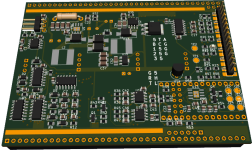thorlancaster328
100 W
- Joined
- May 25, 2018
- Messages
- 197
After several iterations of designing various controllers (https://endless-sphere.com/forums/viewtopic.php?f=30&t=109999) I have designed a controller that (should be able to) do 500 peak amps (600A of FETs) in a 100x70x25mm (including heatsink) package. I (and the rest of my startup) are in the process of patenting the interconnect method for the power stage, so I can't share details on that part until the provisional patent is accepted (est. 3 months).
To drive this power stage, I have designed a prototype Teensy 4.0-based control board that I plan on possibly open-sourcing after a while. Our stock firmware will be proprietary but the board will most likely be eventually VESC, etc. compatible.
So far, the board has the following features:

Additional features that I plan on implementing:
Are there any other features that I should have?
Edit after community feedback: Here are some more planned features that people want:
Note to moderators: I am discussing the portion of the controller that will be open sourced and am not selling these yet. Therefore I believe that this still belongs in the "motor technology" section. I'll move to the buy/sell section when I commercialize this.
To drive this power stage, I have designed a prototype Teensy 4.0-based control board that I plan on possibly open-sourcing after a while. Our stock firmware will be proprietary but the board will most likely be eventually VESC, etc. compatible.
So far, the board has the following features:
- Sensored FOC [Working]
- Temperature sensing for the motor (external), CAPs, and FETs [Working]
- Throttle control and regenerative braking [Working]
- Fast (2uS) hardware overcurrent and overvoltage protection. [Working]
- Integrated on/off switch with zero battery drain (excl. CAP leakage) [Working]
- Custom speed-torque curves for throttle inputs [In development]
- Field weakening [In development]
- Sensorless FOC [In development]
- Sensorless winding temperature measurement [In development]
- Sensorless from standstill [In development]
- CAN-Bus protocol, probably CANOpen [Hardware feature, no software yet]
- Serial command-line programming interface [Hardware feature, no software yet]

Additional features that I plan on implementing:
- IMU chip for traction control and [later] wheelie control
- Compatibility with pulse-based RC radio receivers
- Programming through LED and button like R/C ESCs [Maybe]
- "Hubwoofer" to make the motor sound like an engine or play audio [Maybe, only if you have a clamping torque arm]
Are there any other features that I should have?
Edit after community feedback: Here are some more planned features that people want:
- Ability to do MPPT using the hubmotor's inductance and a step-up transformer to make 120VAC. Turn your eBike into a powerwall. 1kVA transformers are going for $100 used right now so I'l definitely be using this feature myself.
- Switchable 12v output for running cooling fan for above mentioned transformer
- Waterproof, fully potted electronics - I'll pot the control and power stages separately and silicone them together. If a FET ever does fail the control stage can be reused by prying the controller apart with a knife. Likewise, if the control section is damaged by ex. an inadvertent battery wire touching an I/O pin, the power stage can be reused. I already planned this but am listing it here since users mentioned it.
- Optional integrated precharge circuit to prevent arcs when connecting the battery
- Compatibility with SIN/COS position sensors by using spare analog inputs - there will be 4 total
- 150v FETs for higher voltage setups - Can do after the 100v line is released
- Bluetooth dongle - This will be built into the display and the controller will be password-lockable over CAN.
- Cruise control - I can easily add support for this plus a three speed switch by using one of the spare analog inputs and resistors between the controller and the switches.
- Swappable daughterboards that plug into the I/O header on the side for compatibility with various setups (e.g. Chinese hub kit, CycleAnalyst, EggRider ETC)
Note to moderators: I am discussing the portion of the controller that will be open sourced and am not selling these yet. Therefore I believe that this still belongs in the "motor technology" section. I'll move to the buy/sell section when I commercialize this.




